SKODA OCTAVIA 2009 2.G / (1Z) Owner's Manual
Manufacturer: SKODA, Model Year: 2009, Model line: OCTAVIA, Model: SKODA OCTAVIA 2009 2.G / (1Z)Pages: 304, PDF Size: 19.56 MB
Page 251 of 304
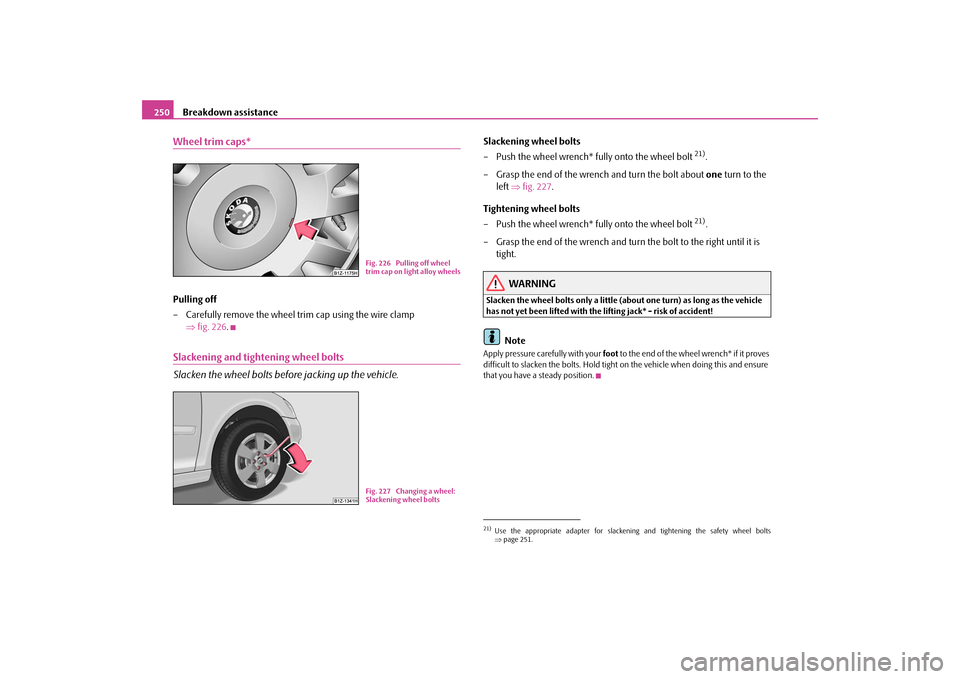
Breakdown assistance
250
Wheel trim caps*Pulling off – Carefully remove the wheel tr
im cap using the wire clamp
⇒
fig. 226
.
Slackening and tightening wheel bolts Slacken the wheel bolts before jacking up the vehicle.
Slackening wheel bolts – Push the wheel wrench* fully onto the wheel bolt
21).
– Grasp the end of the wrench and turn the bolt about
one
turn to the
left
⇒
fig. 227
.
Tightening wheel bolts – Push the wheel wrench* fully onto the wheel bolt
21).
– Grasp the end of the wrench and turn the bolt to the right until it is
tight.
WARNING
Slacken the wheel bolts only a little (a
bout one turn) as long as the vehicle
has not yet been lifted with the lifting jack* - risk of accident!
Note
Apply pressure carefully with your
foot
to the end of the wheel wrench* if it proves
difficult to slacken the bolts. Hold tight on the vehicle when doing this and ensure that you have a steady position.
Fig. 226 Pulling off wheel trim cap on light alloy wheelsFig. 227 Changing a wheel: Slackening wheel bolts
21)Use the appropriate adapter for slackening
and tightening the safety wheel bolts
⇒ page 251.
se0.1.book Page 250 Frida
y, April 10, 2009 3:19 PM
Page 252 of 304

Breakdown assistance
251
Using the system
Safety
Driving Tips
General Maintenance
Breakdown assistance
Technical Data
Raise vehicle You have to raise the vehicle with the lifting jack* in order to be able to take off the wheel.Position the lifting jack* by selecting the jacking point which is closest to the wheel to be removed
⇒
fig. 228
. The jacking point is located directly
below the engraving in the lower sill. The engraving is only visible after opening the door. – Position the lifting jack* below the jacking point and move it up until
its claw is positioned di
rectly below the vertical web of the lower sill.
– Align the lifting jack* so that its claw grasps the web of the lower sill
and the base plate is resting flat on the floor.
– Turn the lifting jack* up further until the wheel is just clear of the
ground.
Ground which is soft and slippery
below the lifting jack* can cause the vehicle to
slip off the lifting jack*. It is therefore al
ways necessary to place the lifting jack* on
a solid surface or use a wide and stable ba
se. Use a non-slip base (e.g. a rubber foot
mat) if the
surface is smooth
, such as cobbled stones, a tiled floor, etc.
WARNING
•
Always raise the vehicle with the doors closed - risk of injury!
•
Take suitable measures to prevent the
base of the lifting jack from slip-
ping off - risk of injury!•
Not positioning the lifting jack* at
the specified points can result in
damage to the vehicle. The lifting jack* ca
n also slip off if it does not have
sufficient grip - risk of injury!•
It is important to support the vehicle with suitable supporting blocks if
you wish to work under the lifted vehicle - risk of injury!Securing wheels against being stolen* You need a special adapter for slackening the safety wheel bolts.– Pull off the full wheel trim/cap from the wheel hub or cap from the
safety wheel bolt.
– Insert the adapter with its toothed side fully into the inner toothing
of the safety wheel bolt right down in such a way that only the outer hexagon is jutting out
⇒
fig. 229
.
– Insert the wheel wrench* fully onto the adapter . – Slacken the wheel bolt, or tighten it firmly
⇒
page 250.
Fig. 228 Changing a wheel: Points for positioning car jac
kAA
AB
Fig. 229 Safety wheel bolt with adapter
AB
AA
AB
se0.1.book Page 251 Frida
y, April 10, 2009 3:19 PM
Page 253 of 304
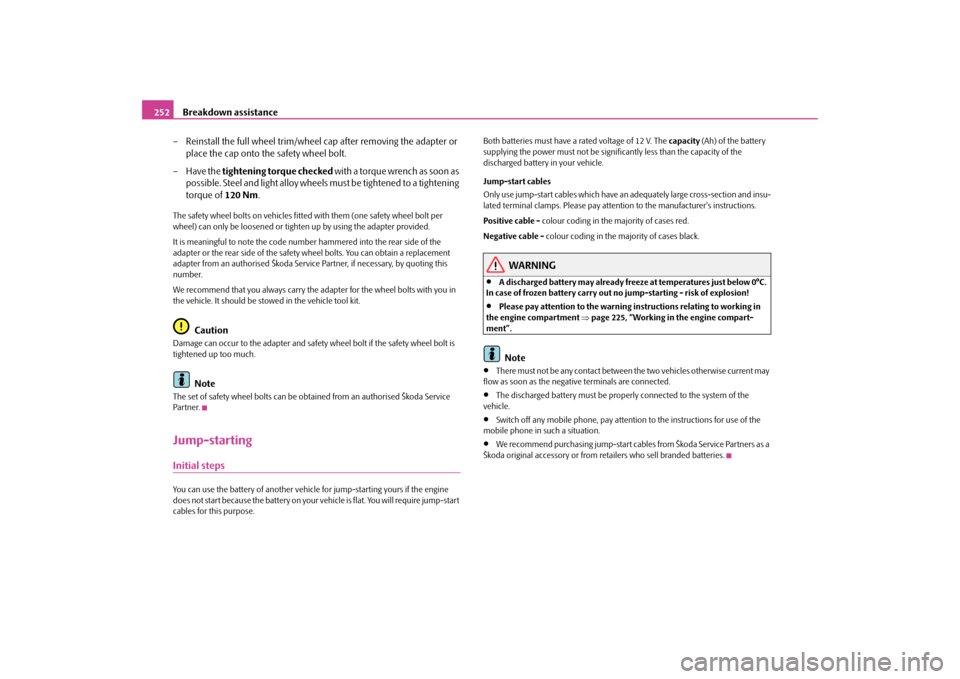
Breakdown assistance
252
– Reinstall the full wheel trim/wheel cap after removing the adapter or
place the cap onto the safety wheel bolt.
– Have the
tightening torque
checked
w i t h a t o rq u e w re n c h a s s o o n a s
possible. Steel and light alloy wheels must be tightened to a tightening torque of
120 Nm
.
The safety wheel bolts on vehicles fitted with them (one safety wheel bolt per wheel) can only be loosened or tigh
ten up by using the adapter provided.
It is meaningful to note the code numbe
r hammered into the rear side of the
adapter or the rear side of the safety wheel bolts. You can obtain a replacement adapter from an authorised Škoda Service Partner, if necessary, by quoting this number. We recommend that you always carry the
adapter for the wheel bolts with you in
the vehicle. It should be st
owed in the vehicle tool kit.
Caution
Damage can occur to the adapter and safety
wheel bolt if the safety wheel bolt is
tightened up too much.
Note
The set of safety wheel bolts can be obta
ined from an authorised Škoda Service
Par tner.Jump-startingInitial stepsYou can use the battery of another vehicl
e for jump-starting yours if the engine
does not start because the battery on your
vehicle is flat. You will require jump-start
cables for this purpose.
Both batteries must have a rated voltage of 12 V. The
capacity
(Ah) of the battery
supplying the power must not be signific
antly less than the capacity of the
discharged battery
in your vehicle.
Jump-start cables Only use jump-start cables which have an
adequately large cross-section and insu-
lated terminal clamps. Please pay attent
ion to the manufacturer's instructions.
Positive cable -
colour coding in the
majority of cases red.
Negative cable -
colour coding in the majority of cases black.
WARNING
•
A discharged battery may already freeze
at temperatures just below 0°C.
In case of frozen battery carry out no jump-starting - risk of explosion!•
Please pay attention to the warning instructions relating to working in
the engine compartment
⇒page 225, “Working in the engine compart-
ment”.
Note
•
There must not be any contact between the two vehicles otherwise current may
flow as soon as the negative terminals are connected.•
The discharged battery must be proper
ly connected to the system of the
vehicle.•
Switch off any mobile phone, pay attent
ion to the instructions for use of the
mobile phone in such a situation.•
We recommend purchasing jump-start cabl
es from Škoda Service Partners as a
Škoda original accessory or from retailers who sell branded batteries.
se0.1.book Page 252 Frida
y, April 10, 2009 3:19 PM
Page 254 of 304
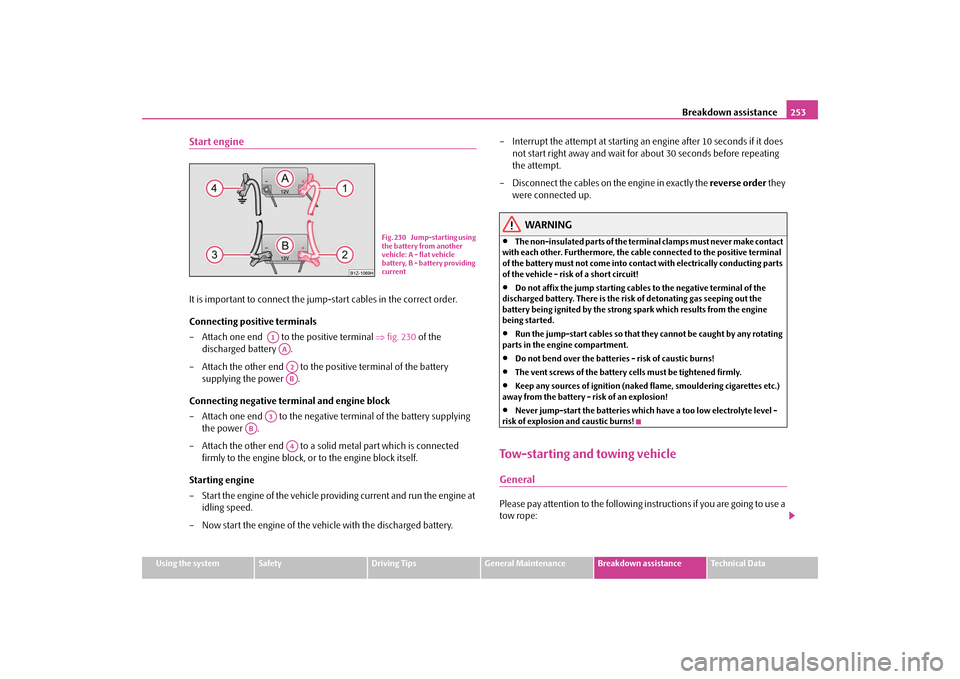
Breakdown assistance
253
Using the system
Safety
Driving Tips
General Maintenance
Breakdown assistance
Technical Data
Start engineIt is important to connect the jump
-start cables in the correct order.
Connecting positive terminals – Attach one end to the positive terminal
⇒
fig. 230
of the
discharged battery .
– Attach the other end to the positive terminal of the battery
supplying the power .
Connecting negative term
inal and engine block
– Attach one end to the negative
terminal of the battery supplying
the power .
– Attach the other end to a solid metal part which is connected
firmly to the engine block, or
to the engine block itself.
Starting engine – Start the engine of the vehicle providing current and run the engine at
idling speed.
– Now start the engine of the vehicle with the discharged battery.
– Interrupt the attempt at starting an engine after 10 seconds if it does
not start right away and wait for about 30 seconds before repeating the attempt.
– Disconnect the cables on the engine in exactly the
reverse order
they
were connected up.
WARNING
•
The non-insulated parts of the terminal clamps must never make contact
with each other. Furthermore, the cable connected to the positive terminal of the battery must not come into contact with electrically conducting parts of the vehicle - risk of a short circuit!•
Do not affix the jump starting cables to the negative terminal of the
discharged battery. There is the risk
of detonating gas seeping out the
battery being ignited by the strong
spark which results from the engine
being started.•
Run the jump-start cables so that th
ey cannot be caught
by any rotating
parts in the engine compartment.•
Do not bend over the batteries - risk of caustic burns!
•
The vent screws of the battery cells must be tightened firmly.
•
Keep any sources of ignition (naked
flame, smouldering cigarettes etc.)
away from the battery - risk of an explosion!•
Never jump-start the batteries which have a too low electrolyte level -
risk of explosion and caustic burns!Tow-starting and towing vehicleGeneralPlease pay attention to the following in
structions if you are going to use a
tow rope:
Fig. 230 Jump-starting using the battery from another vehicle: A - flat vehicle battery, B - battery providing current
A1AAA2AB
A3
AB
A4
se0.1.book Page 253 Frida
y, April 10, 2009 3:19 PM
Page 255 of 304
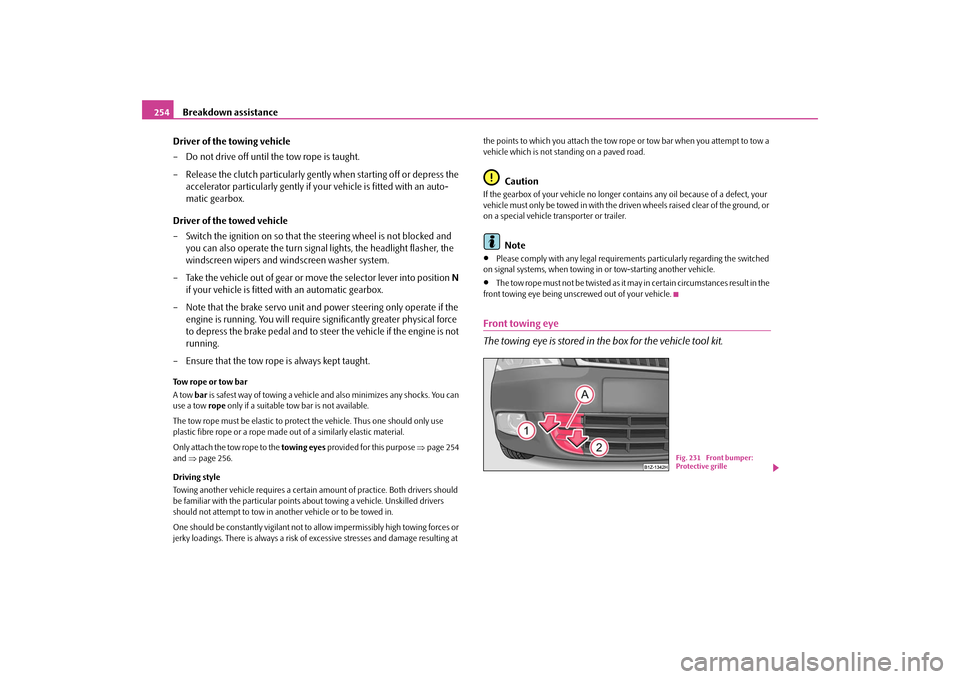
Breakdown assistance
254
Driver of the towing vehicle – Do not drive off until the tow rope is taught. – Release the clutch particularly gent
ly when starting off or depress the
accelerator particularly gently if yo
ur vehicle is fitted with an auto-
matic gearbox.
Driver of the towed vehicle – Switch the ignition on so that the steering wheel is not blocked and
you can also operate the turn signal
lights, the headlight flasher, the
windscreen wipers and wi
ndscreen washer system.
– Take the vehicle out of gear or move
the selector lever into position
N
if your vehicle is fitted with an automatic gearbox.
– Note that the brake servo unit and power steering only operate if the
engine is running. You will require si
gnificantly greater physical force
to depress the brake pedal and to steer the vehicle if the engine is not running.
– Ensure that the tow rope is always kept taught.Tow rope or tow bar A tow
bar
is safest way of towing a vehicle and also minimizes any shocks. You can
use a tow
rope
only if a suitable tow bar is not available.
The tow rope must be elastic to protect
the vehicle. Thus one should only use
plastic fibre rope or a rope made
out of a similarly elastic material.
Only attach the tow rope to the
towing eyes
provided for this purpose
⇒page 254
and
⇒page 256.
Driving style Towing another vehicle requires a certain
amount of practice. Both drivers should
be familiar with the particular points
about towing a vehicle. Unskilled drivers
should not attempt to tow in another vehicle or to be towed in. One should be constantly vigilant not to allow impermissibly high towing forces or jerky loadings. There is always a risk of excessive stresses and damage resulting at
the points to which you attach the tow ro
pe or tow bar when you attempt to tow a
vehicle which is not standing on a paved road.
Caution
If the gearbox of your vehicle no longer
contains any oil because of a defect, your
vehicle must only be towed in with the driven wheels raised clear of the ground, or on a special vehicle transporter or trailer.
Note
•
Please comply with any legal requirements particularly regarding the switched
on signal systems, when towing in
or tow-starting another vehicle.
•
The tow rope must not be twisted as it may in certain circumstances result in the
front towing eye being unscrewed out of your vehicle.Front towing eye The towing eye is stored in the box for the vehicle tool kit.
Fig. 231 Front bumper: Protective grille
se0.1.book Page 254 Frida
y, April 10, 2009 3:19 PM
Page 256 of 304

Breakdown assistance
255
Using the system
Safety
Driving Tips
General Maintenance
Breakdown assistance
Technical Data
Carefully remove the cover as follows. – Guide the fingers into the opening
⇒
page 254, fig. 231
.
– By pulling in the direction of arrow , first of all slacken the cover in
the upper area on the side to the fog lights.
– Afterwards, also slacken the cover on the other side in the direction of
arrow and remove it.
– Screw in the towing eye by hand anticlockwise down to the stop
⇒
fig. 232
and tighten up using the wheel wrench* (push the wheel
wrench* through the eye).
– In order to reinstall the cover after sc
rewing out the towing eye, first of
all insert it starting on the side facing the marking. Then press the cover closed on the side facing the fog light. The cover must engage firmly.
Front towing eye for Octavia RS and Octavia Scout The towing eye is stored in th
e box for the vehicle tool kit.
Octavia RS – Guide one finger into the opening of the grille
⇒
fig. 233
.
– Unlock the cover by pulling it in direction and remove it.– Screw in the towing eye by hand anticlockwise down to the stop
⇒
fig. 232
and tighten up using the wheel wrench* (push the wheel
wrench* through the eye).
Fig. 232 Front bumper: Installing the towing eye
AAA1
A2
Fig. 233 Front bumper Octavia RS: Protective grilleFig. 234 Front bumper Octavia Scout: Cover
AA
A1
se0.1.book Page 255 Frida
y, April 10, 2009 3:19 PM
Page 257 of 304
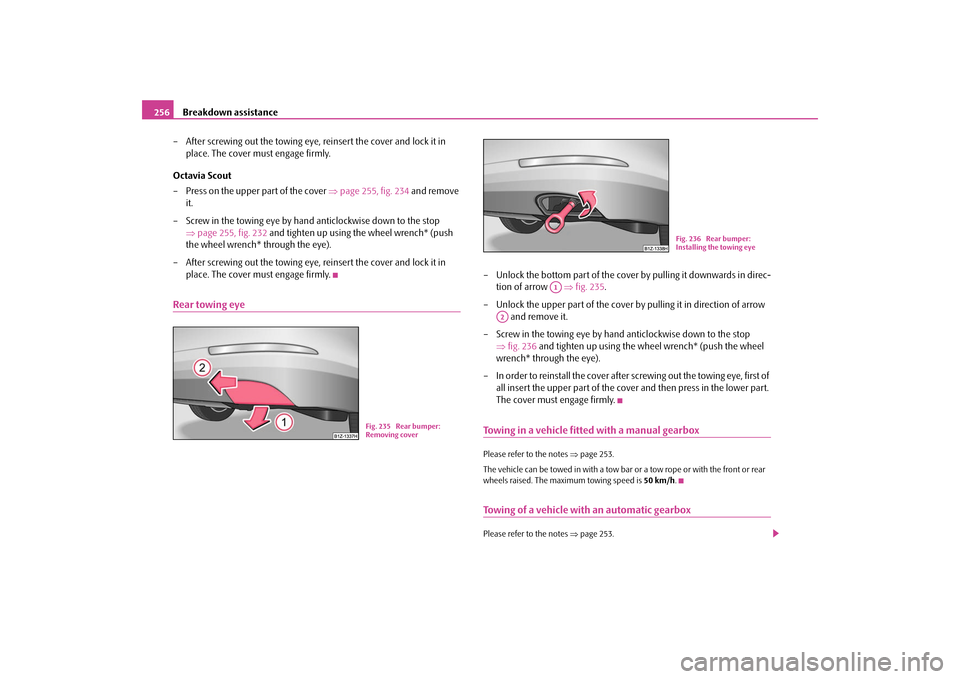
Breakdown assistance
256
– After screwing out the towing eye,
reinsert the cover and lock it in
place. The cover must engage firmly.
Octavia Scout – Press on the upper part of the cover
⇒
page 255, fig. 234
and remove
it.
– Screw in the towing eye by hand anticlockwise down to the stop
⇒
page 255, fig. 232
and tighten up using the wheel wrench* (push
the wheel wrench* through the eye).
– After screwing out the towing eye,
reinsert the cover and lock it in
place. The cover must engage firmly.
Rear towing eye
– Unlock the bottom part of the cover by pulling it downwards in direc-
tion of arrow
⇒
fig. 235
.
– Unlock the upper part of the cover by pulling it in direction of arrow
and remove it.
– Screw in the towing eye by hand
anticlockwise down to the stop
⇒
fig. 236
and tighten up using the wheel wrench* (push the wheel
wrench* through the eye).
– In order to reinstall the cover after screwing out the towing eye, first of
all insert the upper part of the cover and then press in the lower part. The cover must engage firmly.
Towing in a vehicle fitted with a manual gearboxPlease refer to the notes
⇒page 253.
The vehicle can be towed in with a tow bar or a tow rope or with the front or rear wheels raised. The maximum towing speed is
50 km/h
.
Towing of a vehicle with an automatic gearboxPlease refer to the notes
⇒page 253.
Fig. 235 Rear bumper: Removing cover
Fig. 236 Rear bumper: Installing the towing eye
A1
A2
se0.1.book Page 256 Frida
y, April 10, 2009 3:19 PM
Page 258 of 304

Breakdown assistance
257
Using the system
Safety
Driving Tips
General Maintenance
Breakdown assistance
Technical Data
The car can be towed in with a tow bar or
a tow rope. Refer at the same time to the
following guidelines:•
Move
selector lever into N
.
•
The maximum towing speed is
50 km/h
.
•
The maximum permissible towing distance is
50 km
. The gear oil pump does
not operate when the engine is not runni
ng; the gearbox would not be adequately
lubricated at higher speeds an
d over longer towing distance.
Caution
If the vehicle is towed in by a recovery vehi
cle, it should only be towed in with the
front wheels raised. If the vehicle is raised at rear, the automatic gearbox is damaged! (Does not apply to the automatic gearbox DSG).
Note
The vehicle must be transported on a special ve
hicle or trailer if it is not possible to
tow in the vehicle in the way described or if the towing distance is greater than 50 km.Towing a vehicle with four-wheel drivePlease refer to the notes
⇒page 253.
The vehicle can be towed in using a tow ba
r or a tow rope or with the front axle
raised. The maximum towing speed is
50 km/h
, the maximum permissible towing
distance is
50 km
.
Note
The vehicle must be transported on a special ve
hicle or trailer if it is not possible to
tow in the vehicle in the way described or if the towing distance is greater than 50 km.
se0.1.book Page 257 Frida
y, April 10, 2009 3:19 PM
Page 259 of 304

Fuses and light bulbs
258
Fuses and light bulbsElectric fusesReplacing fuses Defect fuses must be replaced.Individual electrical circuits are prot
ected by fuses. The fuses are located
on the left side of the dash panel behind the safety cover and under the cover in the engine compartment on the left. – Switch the ignition off and also the electrical component affected.– Use a screwdriver to take off the fuse cover on the side of the dash
panel
⇒
fig. 237
or the fuse cover in the engine compartment
⇒
page 259.
– Find out which fuse belongs to the relevant component
⇒
page 260,
“Fuse assignment in the dash panel” or
⇒
page 259, “Fuse assignment
in engine compartment”.
– Take the plastic clip out of its fixture in the fuse cover, insert it onto the
respective fuse and pull out this fuse.
– Defect fuses can be detected by th
eir melted metal st
rips. Replace the
defect fuse by a new fuse of the
same
ampere number.
– Fit on the fuse cover again.We recommend that you always have the
small box of replacement fuses in your
vehicle. You can obtain replacement fuses from Škoda original accessories or from a specialist garage
22).
Colour coding of fuses
Caution
•
Never attempt to “repair” fuses and also do not replace them with a fuse of a
higher amperage - risk of fire! This may
also cause damage at another part of the
electrical system.•
Have the electrical system checked as quickly as possible by a specialist garage
if a newly inserted fuse blows again after a short time.
Fig. 237 Fuse cover: left side of the dash panel
22)The small box with replacement fuses is part of the basic equipping of the vehicle in somecountries.
Colour
Maximum amperage
light brown
5
brown
7,5
red
10
blue
15
yellow
20
white
25
green
30
orange
40
red
50
se0.1.book Page 258 Frida
y, April 10, 2009 3:19 PM
Page 260 of 304

Fuses and light bulbs
259
Using the system
Safety
Driving Tips
General Maintenance
Breakdown assistance
Technical Data
Fuse cover in engine compartment The fuse box in the engine comp
artment exists in two different
versions. You can determine which version your vehicle is fitted with after removing the fuse cover at the location of the fuses.On some vehicles, the battery cover
must be removed before removing
the fuse cover
⇒
page 232.
Removing fuse cover – Move the circlips
⇒
fig. 238
as far as the stop, the symbol
appears behind the circlip and remove the cover.
Installing fuse cover – Position the fuse cover on the fuse box and push the circlips as far
as the stop - the symbol
is visible behind the circlip.
Caution
•
When unlocking and locking the fuse cover,
it must be pressed on the sides to
the box, otherwise damage can
occur to the locking mechanism.
•
Carefully position the fuse cover in th
e engine compartment. If the cover was
not correctly positioned, water can get into
the fuses and this results in a damage
to the vehicle!
Fuse assignment in engine compartmentCertain electrical components are only standard on certain vehicle model versions or only suppliable as optional
equipment for certain models.
Fig. 238 Fuse cover in engine compartment
AA
AA
No.
Power consumer
Amperes
F1
Not assigned
F2
Control unit for automatic gearbox DQ 200
30
F3
Measuring circuit
5
F4
Valves for ABS
30/20
F5
Control unit for automatic gearbox
15
F6
Instrument cluster, windshield
wiper lever and turn sig-
nal light lever
5
F7
Power suppy terminal 15, Starter
40
F8
Radio
15
F9
Phone
5
F10
Engine control unit, Main relay
5/10
F11
Control unit for auxiliary heating
20
F12
Control unit for CAN databus
5
Fig. 239 Schematic repre- sentation of fuse carrier in engine compartment
se0.1.book Page 259 Frida
y, April 10, 2009 3:19 PM